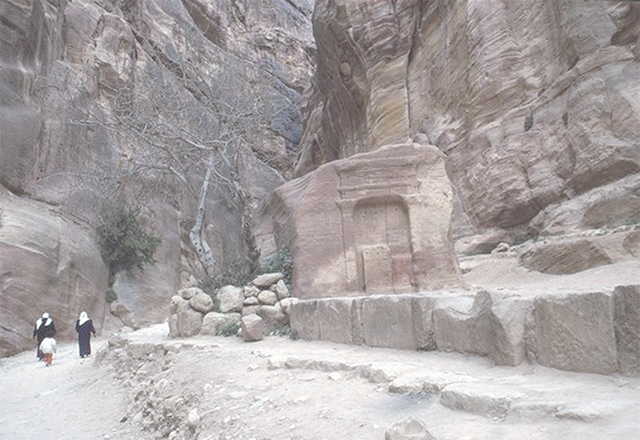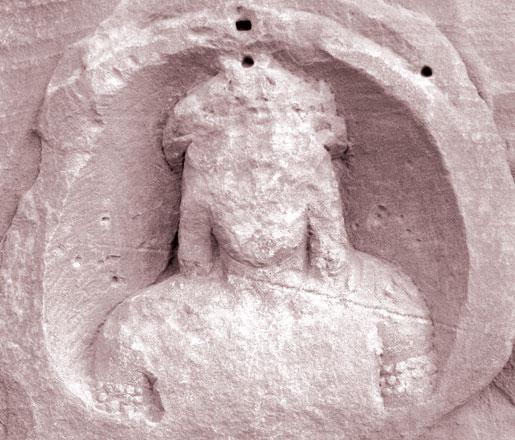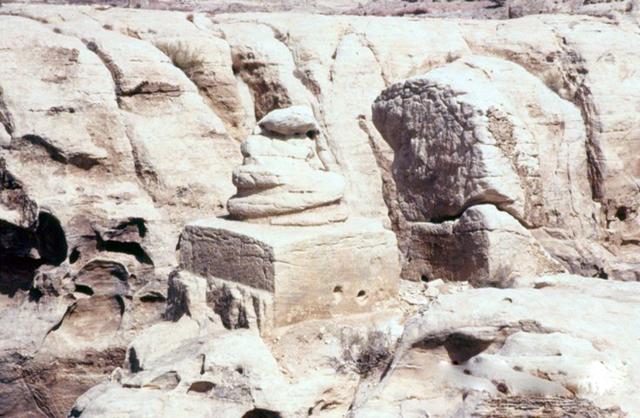You are here
Gods of Nabataeans: Unveiling ancient belief systems through ‘betyls’ studies
By Saeb Rawashdeh - Mar 01,2024 - Last updated at Mar 01,2024

A Nabataean betyl in Petra (Photo courtesy of ACOR)
AMMAN — A team of scholars from Bonn University started a project “The Gods of the Nabataeans” whose objective was to study the pantheon of the ancient inhabitants of Petra. Unlike other Middle Eastern civilisations, the Nabataean belief system remained relatively unknown. The betyl (a standing stone representing a deity) was a popular form of religious practice and many betyls were erected in Petra depicting different gods and goddesses.
However, very few betyls are accompanied by an inscription that identifies the deity. The most popular betyls represented the supreme god Dushara or the female deity Al Uzza.
“Sufficient explanations cannot be reached by the typological classification of the betyls as a more differentiating approach is necessary which considers the framing of the niche, its context and the natural environment or character of the place,” noted Helmut Merklein from Bonn University, adding that these considerations led to a detailed research of the votive niches.
The team studied various sanctuaries of Petra in this context and one of them has the inscription and figure of supreme Egyptian goddess Isis near Wadi as-Siyyagh. Isis was a major goddess in ancient Egyptian religion whose cult spread around the Greco-Roman world.
“This place was first described by J. T. Milik and J. Starcky in 1975, particularly for its inscription, after it was discovered by C. M. Bennett in 1964. H. Donner in 1995 gave valuable comments on the inscription, the figures in the niches and the role of Isis at Petra,” Merklein said, adding that they have been successful in discovering the ancient access from the wadi to the ledge with the votive niches, almost 40 metres above the wadi ground.
The shrine is not easily accessible, as the ledge is difficult to reach and it requires climbing. A narrow passage between some rocks leads from Wadi as-Siyyagh into the gorge, a little above the present wadi bed.
“After two metres, there is a rock-cut stairway to the left. At least eight steps are well preserved and the following part is almost completely eroded, but there wasn’t much need for further steps because a large terrace is reached,” the German professor said, adding that a famous German ethnologist Gustav Dalman described this sanctuary in his works that covered Levant.
“A first survey of the gorge yielded the discovery of a votive niche with a betyl and an unfinished tomb facade, and showed that it is possible to continue to other parts of the area from this gorge,” Merklein said, adding that there are no indications of any cultic function of the niche and it should be explained like the rooms in a domestic context.
Concerning the Isis inscription, dated to 26/25BC, there is a slightly different reading in comparison with the readings by Milik, Starcky and Donner. The left part reads “This goddess [here] is Isis, which have done the sons of...” followed by three names.
“Of these names only Qaiuma is clear, while the reading of the two other names as Barhobal and Tayma seems unfounded, but we cannot provide new names due to the bad preservation of the two lines,” noted Merklein, while the right part of the inscription is better preserved;
“The Isis is shown seated on rocks and the right forearm of this Isis is wrapped in the mantle and is placed across the breast, a feature of the ‘Palliata type’,” Merklein explained, adding that the figure follows none of the common Isis types, but Hellenistic types of draped women.
The figure even misses the Isis knot and without the inscription, nobody would have identified her as Isis as she looks like a majestic enthroned goddess
Petra was a regional centre for centuries and various foreign representatives practiced their religious customs. Moreover, it seems likely that the Nabataeans venerated Isis and liked to represent her in an anthropomorphic type.
“Considering the inscription, the position of the veneration place outside the centre and somewhat hidden in the rocks behind a domestic area, we have to assume that we are dealing with a private holy place,” noted Merklein, adding that a second sanctuary of Isis at Wadi Waqit does not contribute to the assumption of an official cult of Isis in Petra.
Related Articles
AMMAN — Orientalists R.
AMMAN — Petra’s Snake Monument in the southern part of the rose-red city offers clues to the role of serpents in Nabataeans religious practi
AMMAN — Within Nabatean polytheism, the importance of the Nabatean god Dushara increased with the political and economic development of the


















